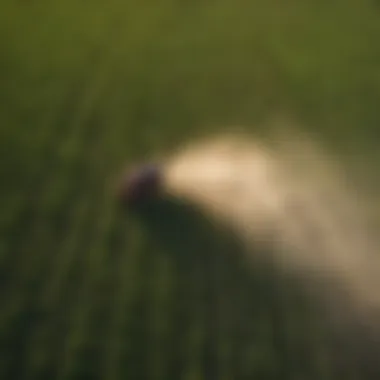Roundup Pest Control: Insights on Safety and Efficacy


Intro
In the world of agriculture, understanding the tools and substances that aid in pest control is crucial. One such substance, glyphosate, commonly found in Roundup products, has stirred extensive discussions about its role, efficacy, and safety. This introductory section will set the stage for a deep dive into Roundup pest control, shining a light on its significance for farmers, agricultural professionals, and anyone mingling with greenery.
Pest control is not just about keeping crops safe; it intertwines with larger themes of sustainability and environmental health. With pests continually adapting and evolving, strategies must evolve too. Roundup stands at the forefront, known for its ability to tackle broadleaf weeds and grasses, but how does it measure up against the backdrop of modern agricultural practices that prioritize ecological balance?
Exploring Roundup pest control encompasses both familiar practices and emerging trends. It leads us to ask critical questions: How effective is glyphosate, really? What are the safety measures that farmers ought to consider? As we begin this exploration, it becomes evident that there's much to unpack in this realm.
"Successful pest management is about understanding your ecosystem and making informed choices that reverberate positively across it."
In the following sections, we will delve into definitions, current trends in pest management, techniques, challenges farmers face, and innovative solutions that can guide agricultural enthusiasts toward sustainable pest control practices.
Understanding Roundup
Understanding the specifics of Roundup is crucial for anyone involved in agriculture, gardening, or land management. This section will explore the foundational aspects that define Roundup and elucidate why it is an essential tool in the pest control toolkit. As various aspects such as efficacy, application methods, and associated risks come into play, it’s also paramount to consider the broader implications of glyphosate use on health and the environment.
What is Roundup?
Roundup is a brand of herbicide widely recognized in the agricultural community for its effectiveness in controlling weeds. The primary component that gives Roundup its potency is glyphosate, a non-selective herbicide that kills a wide range of weeds. Many farmers and gardeners rely on it not just for combatting existing weed problems, but also for preventing future outbreaks. Its versatility makes it a go-to solution in many farming practices.
However, it's important to note that Roundup isn't just a one-size-fits-all solution. The way in which it’s applied, the timing, and the environmental conditions can significantly influence its success. Thus, understanding the characteristics of Roundup is essential for maximizing its use while minimizing potential negative impacts.
Active Ingredient: Glyphosate
Glyphosate is the backbone of Roundup. This chemical works by inhibiting a specific enzyme pathway that is vital for plant growth, known as the shikimic acid pathway. Most plants and some microorganisms are sensitive to glyphosate; thus, when applied, it disrupts their growth processes, leading to weed death.
It's interesting to note that glyphosate is systemic in nature. This means it is absorbed through the foliage and works its way down to the root system, effectively combating even the most tenacious weeds. While glyphosate has proven effective, it has also raised concerns regarding its safety and environmental impact, leading many to ponder the implications of its widespread use.
History of Use
The history of Roundup and its active ingredient, glyphosate, traces back to the 1970s when it was first discovered to be an effective herbicide. Initially, it gained traction due to its ability to control perennial weeds that were difficult to manage with traditional methods. Over the decades, as agricultural practices evolved, glyphosate became increasingly popular, eventually becoming the dominant herbicide worldwide.
In particular, the introduction of genetically modified crops that are glyphosate-resistant in the 1990s led to a dramatic increase in the use of Roundup. Farmers could apply it post-emergence, allowing for weed control without damaging the crops. This shift not only made weed management easier but also enhanced yield potential, transforming agricultural paradigms.
Yet, as time passed, there has been a growing body of research exploring glyphosate's safety, leading to escalating scrutiny. Some studies suggest a possible link between glyphosate exposure and health risks, which has pivotal implications for how Roundup is perceived today. Therefore, the history of Roundup isn't merely a story of agricultural innovation; it reflects an evolving dialogue about agricultural practices, safety, and environmental stewardship.
Mechanism of Action
Understanding the mechanism of action behind Roundup is crucial for grasping how it effectively manages unwanted plants, particularly weeds. This section delves into the scientific workings of glyphosate, illuminating its role in integrated pest management. It's more than just spraying a substance; it’s about recognizing how glyphosate disrupts biological processes in targeted plants while maintaining efficacy and safety for broader ecosystems.
How Glyphosate Works
Glyphosate acts as a systemic herbicide, meaning it gets absorbed through green plant tissues and moves throughout the plant's system. This is critical because it allows the chemical to reach the root structures, thereby addressing the whole plant rather than just its surface.
- When glyphosate enters the plant, it specifically targets the shikimic acid pathway, a metabolic route unique to plants and some microorganisms but absent in animals.
- By inhibiting this pathway, glyphosate halts vital processes required for the synthesis of amino acids like tryptophan, phenylalanine, and tyrosine, stifling the plant’s growth and development.
This mechanism, while effective, begs consideration of various factors such as soil health and overall environmental impact. Understanding how glyphosate functions helps users make informed decisions about its application.


Targeting Specific Plants
The precision of glyphosate is one of its distinguished attributes. It’s designed to target specific plants, particularly annual and perennial broadleaf weeds, which often compete with crops for nutrients, sunlight, and water.
- Selective Control: Glyphosate doesn’t discriminate among plant species but works by exploiting the differences in the metabolism pathways found in susceptible plants. This selectiveness allows farmers to manage weeds without harming their crop plants, which typically lack the shikimic acid pathway.
- Resistant Varieties: In many agricultural settings, glyphosate-resistant crop varieties have been developed, allowing producers to utilize glyphosate as a tool without sacrificing crop yield. Popular resistant crops include soybeans, corn, and cotton, which provide flexibility in management strategies.
Despite the advantages, there's a cautionary tale woven into the narrative of glyphosate use. Continuous reliance on glyphosate has brought about herbicide-resistant weed populations, leading to a burden in agricultural management that requires constant adaptation. Thus, while glyphosate’s ability to target specific plants is a boon, it’s essential to integrate various approaches for effective, long-term pest control.
"Knowledge is power. Understanding the mechanism of action can turn a mere tool into a strategic ally in sustainable agriculture."
In summary, the mechanism of action delineates how glyphosate operates at a cellular level and emphasizes its role in effective weed control, while also serving as a reminder of the complexities of responsible usage in pest management.
Efficacy in Pest Control
Efficacy in pest control serves as a cornerstone in the ongoing conversation about Roundup. When discussing pest management strategies, it’s crucial to not only understand how effective a solution is but also to consider its broader implications. In the world of agriculture, where the stakes are often high, getting this aspect right can mean the difference between a thriving crop and a total loss.
The importance of assessing efficacy cannot be understated. Here are a few key elements to keep in mind:
- Impact on Crop Yield: Effective pest control directly influences crop health and productivity. Farmers need to ensure their chosen methods don’t just eliminate pests, but do so without damaging beneficial organisms.
- Cost-Effectiveness: Financial aspects are also vital. The return on investment associated with various pest control methods can greatly sway decisions. If a product like Roundup proves to be more effective in eradicating weeds compared to its competitors, it could justify its cost.
- Regulatory Compliance: As regulations evolve, being aware of how effective a pest control method is — regarding compliance with local and national laws — is crucial for farmers and industry players alike.
As we move forward in this section, we will delve into specific facets of efficacy in pest control utilizing Roundup as a case study, starting with its effectiveness on the weeds that it targets.
Effectiveness on Weeds
Roundup, primarily known for its effectiveness against a variety of weeds, shows competence in handling even the most persistent of plant adversaries. It's noteworthy that not all weeds are born equal; some develop resistance over time. This variable effectiveness is a critical part of the ongoing management strategies in agriculture.
- Target Range: Glyphosate works particularly well on annual and perennial weeds, including dandelions and thistles. The broad-spectrum nature of Roundup means it can address multiple weed species, making it a go-to solution for many farmers.
- Application Timing: The timing of application is essential. Using Roundup at the right stage of weed growth amplifies its efficacy. Early application before weeds flower can limit seed production, ultimately leading to better long-term management.
- Handling Resistance: Farmers must be proactive in managing glyphosate-resistant weed populations. Solutions range from rotating herbicides to integrating other methods alongside Roundup applications. This multi-faceted approach can preserve the efficacy of glyphosate in a longer run.
"Using Roundup isn’t just about spraying and praying. It’s a strategy that requires understanding how weeds respond to it and acting accordingly.”
Case Studies in Agriculture
Understanding how Roundup performs in real-world applications can provide valuable insights. Numerous case studies illustrate its effectiveness and the scenarios where it shines the brightest.
- Row Crops: In corn and soybean production, Roundup has shown a significant impact on controlling weeds, leading to increased yields. The "no-till" practices allow farmers to minimize soil erosion while employing glyphosate, thus improving both land sustainability and productivity.
- Specialty Crops: Instances in vineyards and orchards reveal how selective use of Roundup provides a powerful tool for maintaining weed control without harming the primary crops. This method is proven in managing inter-row space, benefiting future harvests.
- Case Study of Adoption: Farms that have incorporated Roundup into their routine often report an increase in productivity and a reduction in labor costs related to weeding. This demonstrates the tangible economic benefits of effective pest management.
Limitations of Use
While Roundup has its strengths, recognizing its limitations is equally important for farmers and agricultural professionals. Understanding these can help in making informed decisions.
- Environmental Concerns: The application of glyphosate can raise red flags regarding potential environmental impacts. Concerns about water contamination and effects on non-target plant species demand scrutiny and responsible use.
- Health Implications: Evolving research on glyphosate’s health effects prompts discussions about safety in application and exposure. Farmers need to be cautious, adhering to recommended application guidelines and safety practices.
- Market Dynamics: Changes in consumer attitudes toward herbicides, particularly in organic markets, can affect the viability of using Roundup. As awareness of sustainable practices grows, reliance on chemical solutions may face challenges.
In summary, while Roundup has shown remarkable efficacy in specific pest control contexts, it necessitates a balanced consideration of its strengths and weaknesses. Understanding its effectiveness on weeds, learning from success stories in agriculture, and being aware of limitations can empower farmers and enthusiasts to make better-informed choices in their pest management strategies.
Safety Considerations
Safety considerations are crucial when it comes to Roundup, especially as it relates to health, regulations, and the environment. Understanding these facets is not just about complying with laws or ensuring safe usage; it profoundly impacts the sustainability of agricultural practices and the well-being of ecosystems. As farmers and enthusiasts navigate their pest management strategies, awareness of these safety aspects is pivotal.


Health Impacts
The health impacts of glyphosate, the active ingredient in Roundup, have been at the center of many debates. Some studies suggest a correlation between glyphosate exposure and various health issues, including certain cancers. In contrast, regulatory agencies like the Environmental Protection Agency (EPA) claim glyphosate, when applied according to label directions, poses minimal risk to human health.
Several groups advocate for caution.
- Skin and Eye Irritation: Direct contact can result in irritation.
- Respiratory Issues: Inhalation during application may lead to respiratory problems.
- Long-term Effects: Ongoing research is scrutinizing long-term exposure and potential chronic conditions.
"Understanding the health implications ensures that users of Roundup can make informed decisions."
Late studies underscore the importance of protective gear when handling glyphosate. Farmers should wear gloves, masks, and protective eyewear when mixing or applying the herbicide.
Regulatory Perspectives
The regulatory landscape surrounding Roundup varies by country. In the United States, the EPA regulates glyphosate use alongside state agencies, which also implement specific guidelines. Recent assessments have prompted re-evaluation of glyphosate's safety.
Some key points include:
- Approval Status: Glyphosate has been approved for use in many jurisdictions, but some countries have instituted bans or restrictions due to health concerns.
- User Responsibilities: Farmers must adhere strictly to labeling details, including recommended application techniques and safety measures.
- Continual Research: Agencies are continuously reviewing new studies to ensure safety protocols evolve with emerging science.
This regulatory oversight aims to safeguard public health while allowing producers to utilize effective pest control strategies.
Environmental Risks
The environment bears the brunt of pesticide application, and glyphosate is no exception. Various risks arise from its use that warrant thorough consideration by agricultural professionals and enthusiasts alike.
- Biodiversity Effects: Glyphosate can adversely affect non-target species, potentially leading to a decline in plant and animal populations.
- Soil Health: Some studies indicate that glyphosate can alter soil microbiomes, potentially affecting soil fertility and function.
- Water Contamination: Runoff may introduce glyphosate into nearby waterways, harming aquatic life and disrupting ecosystems.
Understanding these risks helps cultivate a more balanced approach to pest control, fostering practices that prioritize both productivity and environmental stewardship. As the agricultural landscape continues to evolve, recognizing these safety considerations forms the foundation of responsible pest management practices.
Alternatives to Roundup
As agricultural practices evolve, the need for efficient pest control methods continues to be a significant concern among farmers and horticulturists. While Roundup has been a go-to for many because of glyphosate's effectiveness, its controversies and regulatory challenges have opened the door for alternative solutions. Exploring these alternatives not only addresses safety concerns but also positions pest management within a more sustainable framework.
Biological Control Methods
Biological control is all about harnessing nature to combat pests. This approach utilizes living organisms, such as predators, parasitoids, or pathogens, to maintain pest populations at manageable levels. These methods can be incredibly effective and environmentally friendly.
- Predators: Certain insects, like ladybugs or lacewings, can control aphids and other pests.
- Pathogens: Introducing specific fungi or bacteria can infect and reduce pest populations without harming crops.
- Parasitoids: Wasps that lay eggs in pest insects can provide a natural balance, reducing pest numbers effectively.
Biological control methods demand a good understanding of local ecosystems. It’s a balancing act—introducing non-native species, for instance, can upset the natural order, creating new pest problems. Therefore, close attention to local environments and thorough research are paramount.
Cultural Practices in Pest Management
Cultural practices involve modifying agricultural techniques and practices to deter pests. These methods may seem simple but can yield profound results when done correctly.
- Crop Rotation: Altering types of crops grown in a given area can disrupt pest life cycles.
- Sanitation: Keeping fields clear of debris reduces shelter and food for pests.
- Planting Resistant Varieties: Using crop varieties resistant to specific pests can minimize damage.


While these methods may require more effort and planning upfront, their long-term benefits include healthier crops, reduced reliance on chemical controls, and improved soil health. As the saying goes, an ounce of prevention is worth a pound of cure.
Organic Herbicides
Organic herbicides present another layer of alternatives to traditional chemical herbicides like Roundup. They range from natural substances like vinegar or clove oil to commercially produced products derived from natural materials.
Some benefits include:
- Environmental Safety: Most organic options are less harmful to non-target species and ecosystems.
- Human Health: With fewer synthetic chemicals, the risk to farmers, consumers, and wildlife is significantly lower.
- Soil Health: Organic herbicides often do not harm soil microbes, supporting the overall ecosystem within the soil.
However, they do come with challenges. Organic herbicides often require more frequent applications and may not have the same broad-spectrum effectiveness as glyphosate. Moreover, timing and environmental conditions play a critical role in their effectiveness.
Future of Pest Management
The topic of future pest management is more than a mere look into the crystal ball; it’s about recognizing the shifting landscape of agricultural practices and environmental concerns. As we delve into this area, one cannot overlook the pressing need for strategies that not just manage pests efficiently but also harmonize with sustainable and eco-friendly principles. For farmers and agricultural enthusiasts, understanding these future trends presents opportunities to foster productivity while safeguarding the ecosystems they rely upon.
Emerging Technologies
In the realm of pest management, technological advancements are breaking new ground every day. Emerging technologies represent a significant stride towards refining how we combat pests while minimizing damage to the environment. Here are a few noteworthy examples:
- Precision Agriculture: This approach employs satellite imagery and remote sensing to monitor crop health and pest occurrences. By targeting specific areas for treatment instead of blanket applications, farmers can significantly reduce chemical usage.
- Drones: These unmanned aerial vehicles can survey large fields quickly and efficiently. They can identify problem areas, allowing for timely interventions that are both effective and resource-efficient.
- AI and Machine Learning: Data analysis through artificial intelligence helps predict pest outbreaks by analyzing various variables like weather patterns and historical infestation data. It allows for proactive rather than reactive pest management.
These technologies not only increase efficiency but also reduce costs over time. The adoption of such innovations means farmers can address pest challenges head-on, optimizing yields while adhering to increasingly stringent environmental regulations.
Sustainability in Agriculture
Sustainable agriculture is not just a buzzword; it’s a foundational principle shaping the future of farming. In an age where climate change looms large, integrating sustainability into pest management is essential. Here’s how:
- Reduced Chemical Usage: By incorporating methods like integrated pest management (IPM), farmers can lessen their reliance on synthetic pesticides. This approach combines biological control with cultural practices, focusing on preventive measures.
- Soil Health and Ecosystem Balance: Emphasizing sustainable practices improves soil health, which in turn supports diverse ecosystems. Crop rotation and intercropping are two strategies that enhance biodiversity, making crops less susceptible to pests and diseases.
- Water Conservation: Sustainable methods often require less water, crucial in areas facing drought. Techniques such as drip irrigation and rainwater harvesting can help in managing not just pests but resources effectively.
By fostering a culture of sustainability, farmers can secure their livelihoods while nurturing the very land that sustains them. It’s about farming not just for today but for future generations.
“The future of pest management lies in the synergy between advanced technology and sustainable practices, paving the way for a balanced agricultural ecosystem.”
End
In wrapping up our exploration of Roundup pest control, it's vital to consider the numerous dimensions we've navigated throughout this article. We delved into the science behind glyphosate, the efficacy of its application in pest management, and the ongoing debates regarding safety and environmental impacts. The conclusion serves as a lens through which to assess the significance of informed pest control practices.
Summary of Insights
The insights gleaned from the previous sections underscore a couple of key points:
- Efficacy of Glyphosate: This herbicide has proven its worth on a variety of stubborn weeds, making it an asset in agricultural practices. It’s not just a blunt instrument; its targeted action brings efficiency to weed control.
- Health and Environmental Considerations: The ongoing discussions about glyphosate's safety have brought forth imperative considerations for farmers and consumers alike. Recognizing these risks is essential for responsible usage.
- Sustainable Alternatives: With the rise of sustainable practices, exploring alternatives to glyphosate not only addresses environmental concerns but also highlights the future of agriculture, which hinges on integrated approaches.
These points converge to form a nuanced outlook on pest management, where the blend of traditional methods and modern innovations is paramount for future agricultural success.
Final Thoughts on Integrated Pest Management
Integrated Pest Management (IPM) shines as a holistic approach that synthesizes various pest control methods while considering the ecological balance.
As agricultural landscapes continue to face upheaval from climate change and pest resistance, IPM fosters resilience through diverse tactics:
- Combining chemical, biological, and cultural methods creates a robust strategy, ensuring farmers are not reliant on a single point of failure.
- Monitoring and assessment are cornerstones of IPM; observing pest populations and their natural predators feeds into smarter decision-making.
- Educating the community about pest control and the science behind it can encourage safer application practices and foster public trust.
It remains clear that the conversation surrounding glyphosate and Roundup is complex. Whether one leans towards embracing innovative technologies or sticking with tried-and-true practices, the core of effective pest control lies within an informed, balanced approach—something all stakeholders in agriculture can get behind. With an emphasis on education, dialogue, and adaptation, Roundup can be part of a larger, sustainable narrative in pest management.



